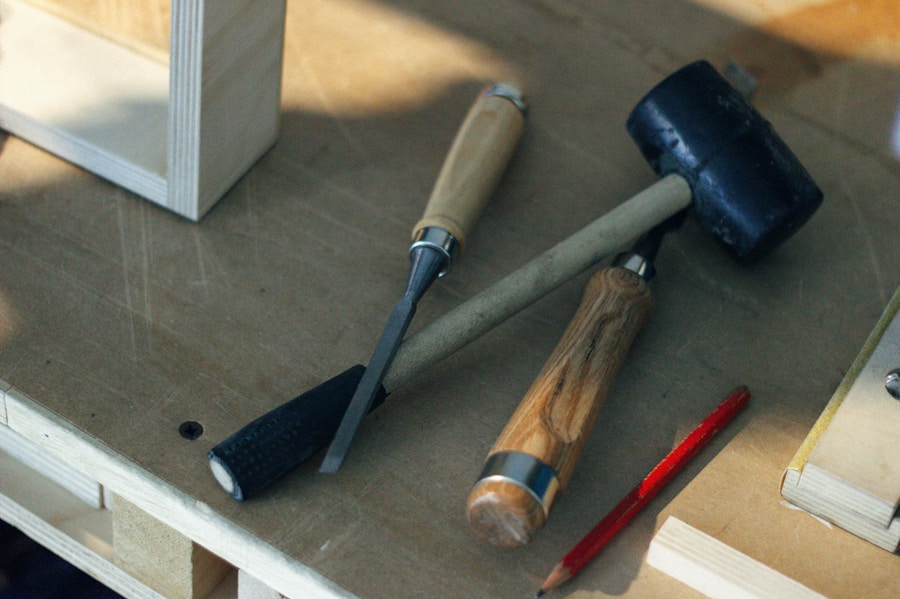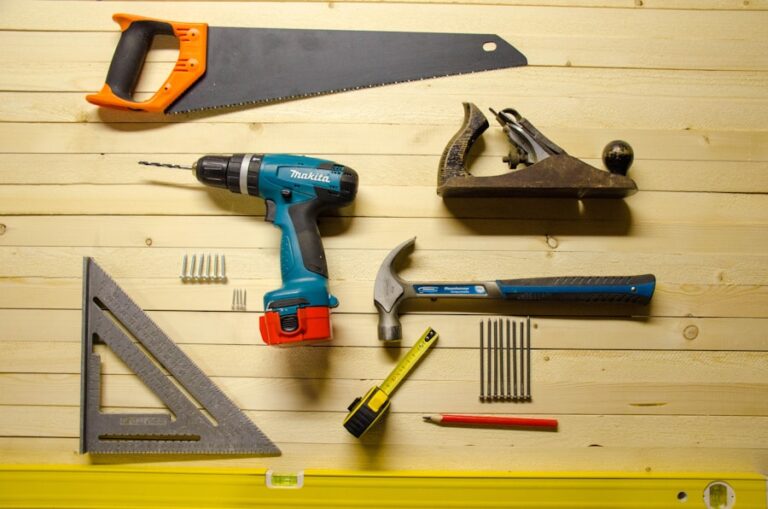Every homeowner should have a basic toolbox filled with essential tools that can tackle a variety of tasks around the house. A well-equipped toolbox not only empowers individuals to handle minor repairs and maintenance but also fosters a sense of independence and self-sufficiency. At the very least, a homeowner’s toolbox should include a hammer, a set of screwdrivers, pliers, a tape measure, and a utility knife.
These fundamental tools serve as the foundation for countless projects, from hanging pictures to assembling furniture. In addition to these basics, homeowners may also benefit from including a level, a wrench set, and a pair of safety goggles in their toolbox. A level ensures that shelves and frames are hung straight, while a wrench set is invaluable for tightening or loosening nuts and bolts.
Safety goggles protect the eyes from debris and dust during various tasks, emphasizing the importance of safety in DIY projects. By investing in these must-have tools, homeowners can be better prepared to address everyday challenges and maintain their living spaces effectively.
Key Takeaways
- Every homeowner should have a basic toolbox with essential tools like a hammer, screwdriver, pliers, and tape measure.
- Power tools like a drill, circular saw, and jigsaw are essential for DIY projects and home repairs.
- Accurate measurements are crucial for precise work, so every homeowner should have measuring tools like a level, ruler, and marking pencil.
- Cutting and shaping tools like a handsaw, chisel, and sander are essential for woodworking and DIY projects.
- Fastening and fixing tools such as nails, screws, and a staple gun are necessary for securing materials and completing projects.
- Safety gear like goggles, gloves, and a dust mask are essential for protecting yourself while working on DIY projects.
- Keeping your tools organized and accessible with toolboxes, pegboards, and shelves is important for efficient DIY work.
- Specialty tools like a pipe wrench, tile cutter, and soldering iron are necessary for specific DIY tasks and projects.
Power Tools: Essential Equipment for DIY Projects
Power tools have revolutionized the way homeowners approach DIY projects, making tasks quicker and more efficient. Among the most essential power tools are drills, saws, and sanders. A cordless drill is particularly versatile, allowing users to drill holes and drive screws with ease.
Its portability means that it can be used in various locations around the home without being tethered to an outlet. This tool is indispensable for assembling furniture, installing shelves, or even hanging curtains. Saws, such as circular saws and jigsaws, are equally important for any homeowner looking to take on more ambitious projects.
These tools enable users to cut through wood and other materials with precision and speed. A circular saw is ideal for making straight cuts in larger pieces of lumber, while a jigsaw excels at intricate cuts and curves. Additionally, sanders help achieve a smooth finish on wood surfaces, making them essential for refinishing furniture or preparing surfaces for painting.
With these power tools in hand, homeowners can confidently tackle a wide range of DIY projects.
Measuring and Marking Tools: Accurate Measurements for Precise Work

Accurate measurements are crucial in any DIY project, and having the right measuring and marking tools can make all the difference. A tape measure is perhaps the most essential tool in this category, allowing homeowners to measure distances with ease. Whether determining the length of a wall for new shelving or measuring furniture for fit, a reliable tape measure is indispensable.
Homeowners should consider investing in a tape measure that features both metric and imperial units for versatility. In addition to tape measures, marking tools such as chalk lines and pencils are vital for ensuring precision in cutting and assembly. A chalk line creates straight lines over long distances, making it easier to mark where cuts should be made.
Pencils are useful for marking measurements on wood or other materials without leaving permanent marks. By utilizing these measuring and marking tools effectively, homeowners can ensure that their projects are executed with accuracy, leading to professional-looking results.
Cutting and Shaping Tools: Essential for Woodworking and DIY Projects
| Tool Type | Function | Common Examples |
|---|---|---|
| Saw | To cut wood along the grain | Circular saw, hand saw, table saw |
| Chisel | To carve and shape wood | Bevel edge chisel, bench chisel, mortise chisel |
| Router | To hollow out an area in wood | Plunge router, fixed-base router, trim router |
| Plane | To flatten and smooth wood surfaces | Jack plane, block plane, smoothing plane |
| Drill | To create holes in wood | Hand drill, cordless drill, drill press |
Cutting and shaping tools are fundamental for any homeowner interested in woodworking or DIY projects. These tools allow individuals to transform raw materials into finished products with ease. Handsaws are traditional cutting tools that remain popular due to their simplicity and effectiveness.
They come in various types, including panel saws for straight cuts and coping saws for intricate shapes. For those looking to invest in power tools, a band saw or table saw can significantly enhance cutting capabilities. Shaping tools such as chisels and routers are also essential for achieving detailed work in woodworking projects.
Chisels allow users to carve out shapes or create joints in wood pieces, while routers can create decorative edges or hollow out areas in wood. These tools enable homeowners to add personal touches to their projects, making them not only functional but also aesthetically pleasing. By mastering cutting and shaping techniques, homeowners can elevate their DIY endeavors to new heights.
Fastening and Fixing Tools: Nails, Screws, and More
Fastening and fixing tools are crucial components of any DIY toolkit, as they hold projects together securely. The most common fastening methods involve nails and screws, each requiring specific tools for application. A hammer is essential for driving nails into wood or other materials, while a screwdriver set is necessary for inserting screws.
Homeowners should consider having both flathead and Phillips screwdrivers on hand to accommodate various types of screws. In addition to traditional fastening methods, homeowners may also benefit from using power tools such as nail guns or impact drivers. Nail guns streamline the process of driving nails into materials quickly and efficiently, making them ideal for larger projects like framing or installing trim.
Impact drivers provide extra torque for driving screws into tougher materials without stripping them. By understanding the different fastening options available, homeowners can choose the right tools for their specific projects, ensuring durability and stability.
Safety Gear: Protecting Yourself While Working on DIY Projects

Protect Your Eyes
Protective eyewear is crucial for shielding the eyes from dust, debris, or flying particles during cutting or drilling tasks. Homeowners should invest in high-quality safety goggles that fit comfortably and provide adequate coverage.
Protect Your Hands and Ears
In addition to eye protection, gloves are another important piece of safety gear that can prevent injuries while handling sharp tools or rough materials. Depending on the project at hand, homeowners may also want to consider wearing ear protection when using loud power tools like saws or drills.
Minimize Risks and Enjoy Your Project
Dust masks can be beneficial when sanding or working with materials that produce fine particles. By prioritizing safety gear, homeowners can minimize risks and enjoy their DIY projects with peace of mind.
Organization and Storage: Keeping Your Tools Neat and Accessible
An organized workspace is essential for efficient DIY projects, making tool storage solutions an important consideration for homeowners. A clutter-free environment not only enhances productivity but also reduces the risk of accidents caused by misplaced tools. Homeowners should invest in toolboxes or storage bins that allow them to categorize their tools effectively.
For example, separate compartments can be designated for hand tools, power tools, and accessories. Wall-mounted pegboards are another excellent option for organizing tools while keeping them easily accessible. By hanging frequently used tools within reach, homeowners can save time searching for items during projects.
Additionally, labeling storage containers can further streamline organization efforts. By implementing effective organization strategies, homeowners can create a functional workspace that promotes creativity and efficiency in their DIY endeavors.
Specialty Tools: Unique Equipment for Specific DIY Tasks
While basic tools cover many common tasks around the home, specialty tools can enhance a homeowner’s ability to tackle specific projects with ease. For instance, tile cutters are invaluable for anyone looking to install new flooring or backsplashes. These specialized tools allow users to make precise cuts in tiles without damaging them, ensuring a professional finish.
Another example of specialty equipment is a drywall lift, which simplifies the process of installing large sheets of drywall on ceilings or walls. This tool allows one person to handle heavy sheets safely without straining their back or risking injury. Similarly, laser levels provide advanced accuracy when aligning shelves or fixtures across long distances.
By incorporating specialty tools into their arsenal, homeowners can expand their capabilities and take on more complex DIY projects with confidence. In conclusion, equipping oneself with the right tools is essential for any homeowner looking to engage in DIY projects successfully. From basic hand tools to specialized equipment, each category plays a vital role in ensuring that tasks are completed efficiently and safely.
By investing time in understanding these tools and how they can be utilized effectively, homeowners can enhance their skills and enjoy the satisfaction that comes from creating and maintaining their living spaces.
If you’re interested in transforming a space in your home into a functional work area, you may want to check out this article on how to convert a shed into a functional work or living space. This comprehensive guide provides tips and tricks for making the most out of your DIY tools to create a space that suits your needs. Whether you’re looking to set up a workshop or a cozy living area, this article has you covered.
FAQs
What are DIY tools?
DIY tools are tools that are used for do-it-yourself projects, home repairs, and other tasks that can be completed without the help of a professional.
What are some common DIY tools?
Common DIY tools include hammers, screwdrivers, wrenches, pliers, drills, saws, tape measures, levels, and many others.
Why are DIY tools important?
DIY tools are important because they allow individuals to complete tasks and projects on their own, saving time and money. They also empower individuals to take on new challenges and learn new skills.
Where can I buy DIY tools?
DIY tools can be purchased at hardware stores, home improvement stores, online retailers, and specialty tool shops.
What should I consider when buying DIY tools?
When buying DIY tools, consider the quality, durability, and versatility of the tools. It’s also important to consider your specific needs and the types of projects you plan to tackle.
How should DIY tools be maintained?
DIY tools should be cleaned and stored properly to maintain their performance and longevity. Regular maintenance, such as oiling moving parts and sharpening blades, is also important.






